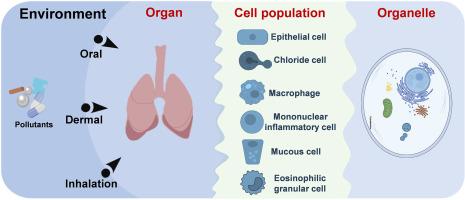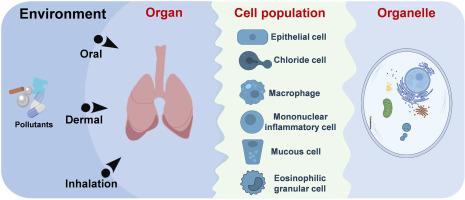污染物在脊椎动物中的分布:器官、细胞和细胞器
IF 7.3
2区 环境科学与生态学
Q1 ENVIRONMENTAL SCIENCES
引用次数: 0
摘要
污染物积累模式对了解其毒性机制和健康风险至关重要。准确地识别污染物积累地点和毒性目标需要对它们在多个尺度上的分布有一个综合的了解。本文系统地研究了环境污染物在脊椎动物中跨器官、细胞和亚细胞水平的多尺度分布的最新进展。它强调了暴露途径(吸入、摄入、皮肤)和分配系数对污染物生物分布的影响,同时也强调了污染物生物转化产生的不确定性。与金属和小分子有机物相比,纳米材料通常具有较低的分配系数,其分布更容易受到暴露途径的影响。传统的研究侧重于器官水平的分布,而新兴的高分辨率技术(如单细胞测序)正越来越多地揭示细胞尺度上的污染物动态。然而,只有有限的研究探讨了污染物在细胞群和亚细胞水平上的分布。大多数研究集中于污染物在血液、肠道、肝脏和鳃/肺中的细胞分布。剩余的工作主要局限于NMs的多尺度分布。未来的研究应优先考虑跨尺度成像技术、计算预测模型,并更加关注血液和亚细胞区室中的污染物物种形成。通过弥合宏观累积和微观毒性机制之间的差距,本综述为推进环境健康风险评估和有针对性的干预提供了框架。本文章由计算机程序翻译,如有差异,请以英文原文为准。


Pollutant distribution in vertebrates across scales: Organs, cells, and organelles
Pollutant accumulation patterns are essential for understanding their toxicity mechanisms and health risks. Accurately identifying pollutant accumulation sites and toxicity targets requires an integrated understanding of their distribution across multiple scales. This review systematically examines recent advances in the multi-scale distribution of environmental pollutants in vertebrates, spanning organ, cellular, and subcellular levels. It highlights the influence of exposure pathways (inhalation, ingestion, dermal) and partition coefficients on pollutant biodistribution, while also emphasizing the uncertainties arising from pollutant biotransformation. Compared to metals and small-molecule organics, nanomaterials (NMs) generally exhibit lower partition coefficients, and their distributions are much susceptible to the exposure pathway. While traditional studies focus on organ-level distribution, emerging high-resolution techniques (e.g., single-cell sequencing) are increasingly revealing pollutant dynamics at the cellular scale. However, only limited studies have explored pollutant distribution at the cell population and subcellular levels. Most research has concentrated on the cellular distribution of pollutants in the blood, intestine, liver, and gill/lung. The remaining works are largely limited to the multi-scale distribution of NMs. Future research should prioritize cross-scale imaging technologies, computational predictive models, and a greater focus on pollutant speciation in blood and subcellular compartments. By bridging the gap between macroscopic accumulation and microscopic toxicity mechanisms, this review provides a framework for advancing risk assessment and targeted interventions in environmental health.
求助全文
通过发布文献求助,成功后即可免费获取论文全文。
去求助
来源期刊

Environmental Pollution
环境科学-环境科学
CiteScore
16.00
自引率
6.70%
发文量
2082
审稿时长
2.9 months
期刊介绍:
Environmental Pollution is an international peer-reviewed journal that publishes high-quality research papers and review articles covering all aspects of environmental pollution and its impacts on ecosystems and human health.
Subject areas include, but are not limited to:
• Sources and occurrences of pollutants that are clearly defined and measured in environmental compartments, food and food-related items, and human bodies;
• Interlinks between contaminant exposure and biological, ecological, and human health effects, including those of climate change;
• Contaminants of emerging concerns (including but not limited to antibiotic resistant microorganisms or genes, microplastics/nanoplastics, electronic wastes, light, and noise) and/or their biological, ecological, or human health effects;
• Laboratory and field studies on the remediation/mitigation of environmental pollution via new techniques and with clear links to biological, ecological, or human health effects;
• Modeling of pollution processes, patterns, or trends that is of clear environmental and/or human health interest;
• New techniques that measure and examine environmental occurrences, transport, behavior, and effects of pollutants within the environment or the laboratory, provided that they can be clearly used to address problems within regional or global environmental compartments.
 求助内容:
求助内容: 应助结果提醒方式:
应助结果提醒方式:


